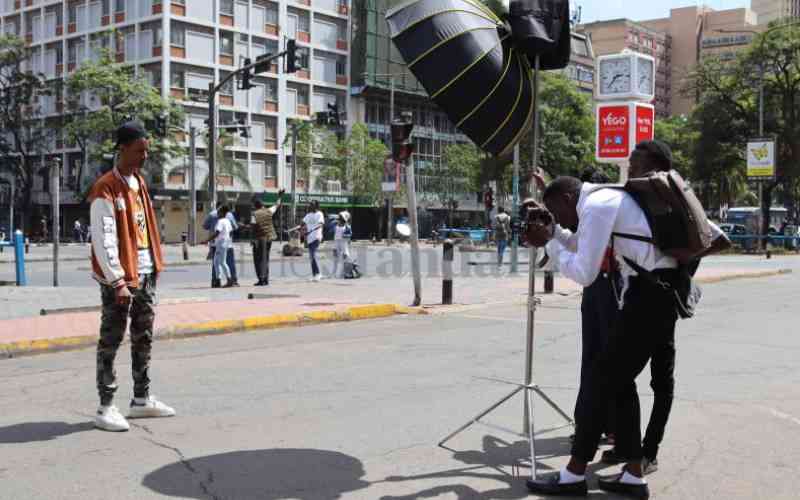By Harold Ayodo
Nairobi’s Central Business District (CBD) is built on a history of exclusion entrenched by colonial master plans that promoted racial segregation. In this arrangement, Africans were the losers as the colonial Europeans and the entrepreneurial Asians claimed the CBD.
But a walk along Moi Avenue (formerly Government Road), Kimathi Street, Koinange Street and Kenyatta Avenue depicts that locals now own prime buildings on streets that for decades were preserves of upper class Europeans and Asians.
The middle class dominates the city in form of stalls and exhibitions, selling assorted wares including clothes, shoes and electronics. These have phased out the Asian-style dukas and the dukawallas, for example on Biashara Street.
There is also the emergence of the Somali businessmen who are turning many areas of the CBD into ‘non-drinking zones’.
They have taken over former pubs and transformed them into restaurants, some serving Somali cuisine.
Renovated
We sought to trace how urban planners of yore managed to restrict Kenyans from the CBD.
According to Charles Karisa, a lecturer at the Department of Urban and Regional Planning, at the University of Nairobi, the taking over of the CBD has several explanations.
"Initially, the CBD was strictly meant for European and Asian traders. Natives had no place. But natives took charge following an exodus of European and Asian businessmen to satellites like Muthaiga, Karen, Runda and Westlands," Karisa says.
Natives then started filtering into the CBD and took over shops and office spaces to set up businesses, which thrive to date.
Karisa, also an architect, says some buildings were renovated and redesigned to suit their new clientele. An example is Kipande House, which was used by the colonial government to issue national identity cards and now hosts the Kenya Commercial Bank.
The renovation increased the value and rent of the buildings and this led to the emergence of numerous stalls.
"Rent of property became too high after buildings were renovated. Therefore, landlords resolved to subdivide into stalls for more locals to afford," Karisa says.
Also, the influx of Somali businessmen promoted the bazaar concept, which is a core feature of the Islamic economy.
Stay informed. Subscribe to our newsletter
Take the case of Jamia Mall that has several stalls under one roof. Such establishments are transforming the face of the CBD.
According to Karisa, the ownership, occupation and planning of the CBD has come a long way since the inaugural construction of the railway in early 1900s.
The first plan was a temporary private one that dated back to 1906 for a railway depot as it sought to mainly address European and Asian low cadre workers and support staff.
The African CBD
The Asians pitched camp at areas around the present day Jamia Mosque, Biashara Street, Tom Mboya Street, Accra Road and River Road.
Europeans took over Kenyatta Avenue, Moi Avenue, Harry Thuku Road and the Museum Hill roundabout as their business area.
"Railway quarters in Muthurwa and Landi Mawe were for low cadre European and Asian railway workers while natives lived in Kariokor and Shauri Moyo," Karisa says.
However, the colonial government came up with a settler plan in 1927 that abolished racial segregation of the CBD, but introduced class segregation.
Consequently, the high-income areas where properties were of lucrative value were a preserve of whites and some middle class Asian families.
"Europeans controlled 90 per cent of the CBD while Asians and native Africans shared the paltry ten per cent," Karisa says.
There was another master plan for a colonial capital in 1948 that sought to divide the CBD into functional zones that were either high density or low density. High-density areas allowed high-rise buildings of up to ten floors while low-density areas accommodated five floors.
Koinange, Banda, Tom Mboya, Haille Selassie and Uhuru Highway were high-density zones and mainly occupied by Europeans.
Asians dominated the present day Banda Street and University way while natives pitched camp at Tom Mboya Street, a low-density area.
"It is for the same reasons that River Road later acquired the name ‘the African CBD’," says Karisa.
Then in 1973, the metropolitan road strategy sought to address problems facing the local populace in Nairobi and also entailed a framework for future growth and proposed satellites like Westlands, Athi River and Mavoko.
But the tactics of exclusion in the CBD have been advanced by the efforts to discourage informal trade, with the City Council consigning hawkers to designated markets like Muthurwa and Gikomba.
Kenyans of Africa descent have, therefore, transformed hawking into the ubiquitous stalls culture, and this keeps the council askaris off them.
While order and neatness is important in the CBD, the African CBD has proved that for a populated city like Nairobi, there needs to be a little piece of the cake for everyone, and informal and small-scale trade are the way to go.
 The Standard Group Plc is a
multi-media organization with investments in media platforms spanning newspaper
print operations, television, radio broadcasting, digital and online services. The
Standard Group is recognized as a leading multi-media house in Kenya with a key
influence in matters of national and international interest.
The Standard Group Plc is a
multi-media organization with investments in media platforms spanning newspaper
print operations, television, radio broadcasting, digital and online services. The
Standard Group is recognized as a leading multi-media house in Kenya with a key
influence in matters of national and international interest.
 The Standard Group Plc is a
multi-media organization with investments in media platforms spanning newspaper
print operations, television, radio broadcasting, digital and online services. The
Standard Group is recognized as a leading multi-media house in Kenya with a key
influence in matters of national and international interest.
The Standard Group Plc is a
multi-media organization with investments in media platforms spanning newspaper
print operations, television, radio broadcasting, digital and online services. The
Standard Group is recognized as a leading multi-media house in Kenya with a key
influence in matters of national and international interest.









